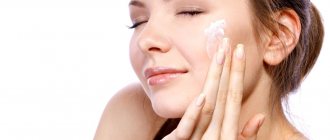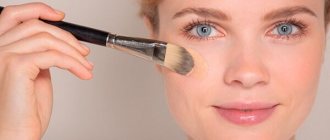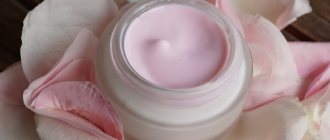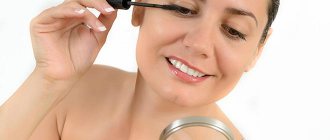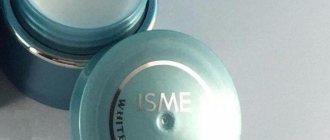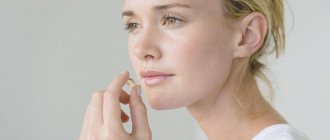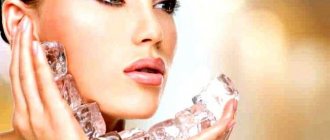Does hydroquinone help with age spots?
Creams containing the active substance hydroquinone are used for aging skin, for skin with a large number of freckles, acne, discoloration due to melasma and age spots.
Quinol (the old name for hydroquinone) neutralizes tyrosine, which contains copper, through a chemical reaction. It blocks oxidation and prevents metabolic processes from developing - just like vitamin C from a squeezed lemon prevents a cut apple from darkening.
Hydroquinone is very toxic, so its content in cosmetics is minimal (no more than 2%). To avoid allergies, creams containing it must be used very carefully. But even a small amount of cream can have a positive effect on skin affected by age spots. The result makes itself felt within two weeks after using the whitening cream.
Dr. Charlene DeHaven
Medical Director of Innovative Skinkia
Surface application of hydroquinone is widespread throughout the world as a bleaching agent. For cosmetic use, hydroquinone is chemically synthesized. It is found in cosmetics in concentrations of up to 15% or more, but the FDA requires a prescription from a doctor for products containing more than 2% of this substance. The Cosmetic Ingredients Expert Panel states that hydroquinone should not be used in leave-on cosmetic products. Despite this, many sites on the Internet offer cosmetics with hydroquinone in concentrations of more than 2% and very often even 4% or higher.
The UN World Health Organization states: “It is recommended to limit the direct retail sale of creams containing hydroquinone. Educational programs need to be implemented to discourage the use of hydroquinone creams..."
Hydroquinone was originally introduced many years ago as a less toxic alternative to mercury-containing bleaches. Now much attention is being paid to the potential toxicity and side effects of hydroquinone itself.
Mechanism of action
Hydroquinone penetrates easily into the skin, and its ability to be absorbed is greatly increased if alcohols are also present in the topical formula. Hydroquinone acts on the functional components of cells and affects cellular metabolism. Hydroquinone has a cytotoxic (cell-damaging or cell-killing) effect on melanocytes (skin cells that produce melanin) and many other cell types. The toxic effect of hydroquinone on cells is caused by the mechanism of free radical oxidation. Free radicals have great damaging potential on their own, and can also damage neighboring cells or their structural components. Because this effect harms the genetic material inside melanocytes, it can lead to the development of cancer cells.
Comparison with other whitening ingredients
Arbutin, which is of plant origin, reduces the production of the skin pigment melanin. Arbutin inhibits the enzyme tyrosinase, which is involved in one of the stages of melanin production. This inhibition of melanin pigment has no cytotoxic effect.
Kojic acid, which is also a plant-derived alpha-hydroxy acid, is another tyrosinase inhibitor. It reduces the production of pigment by melanocytes, similar to arbutin. The presence of these two ingredients in the product enhances the whitening effect of each, especially if this product is applied during the daytime.
Laser technologies are widely used in the treatment of pigmentation disorders, but they involve surgical procedures and have their own potential complications. Laser procedures should be performed under the guidance of a physician to avoid risks and achieve good results.
The formation of pigment in the skin can be regulated at any stage of this process. Several of these steps involve melanocytes, but there are several other necessary steps that do not involve melanocytes. And the only place of action of hydroquinone is its cytotoxic effect on melanocytes. In addition to cell damage or death, hydroquinone also causes severe inflammation of adjacent structural components of the skin.
Potential Side Effects
It was previously believed that hydroquinone concentrations of 2% or lower had a low likelihood of side effects. We know this is not true because medical evidence shows problems occur at lower concentrations. The superficial side effects following hydroquinone application are thought to be due to its cytotoxic mechanism. Another early myth was that the side effects of hydroquinone only appeared on highly pigmented skin. This is also incorrect, since there is evidence in the medical literature that ethnic groups with low levels of hyperpigmentation - Asians, Hispanics, Europeans and African Americans - also suffer from hydroquinone side effects. Application of hydroquinone to the skin followed by exposure to sunlight significantly increases its potential toxicity. In addition, hydroquinone penetrates the skin and can then be found in urine after superficial application. When taken orally, hydroquinone is absorbed very quickly from the gastrointestinal tract and can cause harm to the kidneys and liver. In the presence of water and at room temperature, hydroquinone is converted to quinone, which can cause eye irritation, which in turn can lead to serious problems such as conjunctivitis and corneal erosion (open sores in the center of the eye). Potential side effects including inflammation (redness) and cell damage (associated with free radicals) can lead to severe reactive hyperpigmentation. The potential development of tumor cells is also a concern.
Inflammation . According to the results of a test in which hydroquinone at a concentration of 2% to 5% was applied to the skin 5 days a week for 13 weeks, redness (or erythema) - an indicator of inflammation - was guaranteed to appear. This redness goes away after application is complete, but the skin becomes inflamed while using a hydroquinone product. Most people showed inflammatory results on their skin with any concentration of hydroquinone. Due to the fact that this substance is toxic to cells, even if the redness is not visible to the naked eye, inflammation is still present, since this process is caused by cell damage. This is a type of irritant dermatitis, or inflammation of the skin caused by an irritant substance.
Irritation or allergic dermatitis . This is an allergic reaction of the body to a substance to which the skin has become sensitive. Dermatitis may begin with an inflammatory reaction, but the skin can become so sensitive to the action of a substance that a person may become inflamed if even a small amount is applied to the skin, or even when the body is applied to substances to which the body previously had no reaction.
Physiological effect on the entire body . Hydroquinone penetrates easily through the skin and can be detected in urine as the intact parent substance (rather than a metabolic product) after application of a 2% cream. The concern here is the fact that liver damage may occur when the substance is taken orally, given that hydroquinone, when applied topically, must travel through the bloodstream through the entire body in order to be detected in urine. This raises other questions about the oncological potential and other cytotoxic properties of hydroquinone, which may occur due to hydroquinone's ability to penetrate the skin and have systemic physiological effects throughout the body. Toxic damage to blood cells and leukemia are associated with superficially applied hydroquinone, which penetrates the skin and is absorbed by the body.
Dyschromia . Literally, dyschromia means “abnormal loss of skin color.” Even though hydroquinone is used to lighten skin, the end result can be large areas of uneven skin color. Dyschromia is very unpleasant to look at and difficult to treat. Since hydroquinone itself is the cause of dyschromia, it cannot be an effective treatment for it. Laser therapy is sometimes prescribed, but it is not always effective, requires surgical procedures and has its own potential complications.
Dyschromia . This is a particularly severe type of dyschromia. Moreover, once it appears, it is almost impossible to control. Another type of such pigmented skin disease is hereditary. In this case, it may be associated with a malignant disease. But its exogenous (that is, caused by external factors) type is associated with the surface application of hydroquinone. It causes increased pigmentation in any area of the skin exposed to hydroquinone. Most patients with ochronosis have greater genetically determined melanin production. Ochronosis is particularly common in black South Africans, who frequently use bleaching products containing 27% hydroquinone. This disorder also occurs in Asians, Spaniards, and Europeans when using hydroquinone. Treatment of this disease is extremely difficult, since improvements occur very slowly or do not occur at all. The photo below demonstrates the effects of ochronosis.
Macular hyperchromia, a type of ochronosis demonstrated in the photo above, manifests itself in increased pigmentation of the skin around the eyes. It occurs in one third of black Africans who use bleaching creams containing hydroquinone. Improvement in this condition occurs very slowly.
Striae are stretch marks that often appear after pregnancy or with a sharp increase in body weight. Their appearance may also be associated with the use of hydroquinone. Striae usually do not go away and appear as a result of inflammation and scarring caused by the application of hydroquinone.
Very sharp repigmentation . This condition, described in the medical literature, is associated with the disease vitiligo, in which very dramatic repigmentation occurs after stopping the use of hydroquinone. Vitiligo is a disease that manifests itself in pigmentless, very pale areas of skin that are mixed with normally pigmented areas. The usual treatment is to apply bleaching agents to the normally pigmented area, promoting the loss of melanin, thereby evening out the color of the depigmented areas of the skin. Improvement of this condition is possible, but its results are very easy to lose within a few weeks as the skin repigments very quickly.
Discoloration of nails . Nails may turn brown when using bleaching products containing 4% hydroquinone and tretinoin. When you stop using this cream, the color of your nails is gradually restored.
Neuropathy . The only reported case of neuropathy associated with topical hydroquinone in the medical literature involved gradually increasing weakness in the legs. This patient applied hydroquinone bleaching products for 4 years. She stopped using such creams, and after 4 months the weakness in her legs stopped.
Current Application
Topical products containing hydroquinone at concentrations of 4% or higher can still be found on black markets, especially in developing countries. In the US and elsewhere, hydroquinone can only be prescribed by a doctor, especially in combination with topical steroids, which can reduce side effects. Most doctors prescribe hydroquinone for short-term use, expecting patients to use it temporarily. However, almost always after stopping a course of hydroquinone, hyperpigmentation returns or reactionary hyperpigmentation develops. This is especially problematic for the patient if their treatment is not under the supervision of a physician. Due to this and other factors mentioned earlier in this article, both consumers and doctors are more interested in whitening products that do not contain hydroquinone.
Literature
"Postinflammatory Hyperpigmentation: a Review of the Epidemiology, Clinical Features, and Treatment Options in Skin of Color", Davis EC, Callender VD; J Clin A esthet Dermatol. 2010 Jul;3(7):20-31.
"First Cases of Squamous Cell Carcinoma Associated with Cosmetic Use of Bleaching Compounds", Ly F, Kane A, Deme A, Ngom NF, Niang SO, Bello R, Rethers L, Dangou JM, Dieng MT, Diousse P, Ndiaye B; Ann Dermatol V enereol. Feb 2010; 1 37(2): 1 28-31.
“Different Therapeutic Modalities for Treatment of Melasma”, Azzam OA, Leheta TM, Nagul NA, Shaarawy E, Hay RM, Hilal RF; J Cosmet Dermatol. 2009 Dec;8(4):275-81.
"Skin Lightening and Depigmenting Agents", Policarpio B, Lui H, eMedicine/WebMD, 2009 Oct 26.
Melasma: Treatment Evaluation, Salem A, Gamil H, Ramadan A, Harras M, Arner A; J Cosmet Laser Ther, 2009 Sep;1 1(3):146-50.
"A Split-Face, Double-Blind, Randomized and Placebo-Controlled Pilot Evaluation of a Novel Oligopeptide for the Treatment of Recalcitrant Melasma", Hantash BM, Jimenez F; J Drugs Dermatol. 2009 Aug;8(8):732-5.
“Management of Hyperpigmentation in Darker Racial Ethnic Groups,” Grimes PE; Semin Cutan Med Surg. 2009 Jun;28(2):77-85.
"Aesthetic Problems Associated with the Cosmetic Use of Bleaching Products", Ly F, Sok o AS, Dione DA, Niang SO, Kane A, Bocoun TI, Dieng MT, Ndiaye B; Int J Dermatol. 2007 Oct;46 Suppl 1:15-7.
“Skin Lightening Preparations and the Hydroquinone Controversy”, Draelos ZD; Dermatol Ther. 2007 Sep-Oct;20(5):308-13.
"Hydroquinone: Acute and Subchronic Toxicity Studies with Emphasis on Neurobehavioral and Neurotoxic Effects", Topping DC, Bernard LG, O'Dnoghue JL, English JC; Food Chem T oxicol. 2007 Jan;45(1):70-8.
"Hydroquinone and its Analogues in Dermatology—a Risk-Benefit Viewpoint", O'Donoghue JL; J Cosmet Dermatol. 2006 Sep;5(3):196-203.
"Hydroquinone Health and Safety Guide", United Nations Environment Programme, World Health Organization, Geneva 1996.
“Exogenous Ochronosis in a Mexican-American Woman,” Cutis, K. L. Howard, B. B. Furner; 1990 Mar;45(3):180-2.
“Effect of Antioxidants on Radical Intensity and Cytotoxicity of Hydroquinone”, H Terasaka, F Takayama, K Satoh, S Fujisawa, H Sakagami; Anticancer Res; 2000 Sep-Oct;20(5B):3357-62.
"Lack of Nephrotoxicity and Renal Cell Proliferation following subchronic Dermal Application of a Hydroquinone Cream", RM David, JC English, LC Totman, C Moyer, JL O'Donoghue; Food Chem Toxicol; 1998 Jul;36(7):609-1 6.
"Human In Vivo and In Vitro Hydroquinone Topical Bioavailability, Metabolism, and Disposition", RC Wester, J Melendres, X Hui, R Cox, S Serranzana, H Zhai, D Quan, HI Maibach; J Toxicol Environ Health A; 1998 Jun 26;54(4):301-17.
"Inhibitors of Mammalian Melanocyte T yrosinase: In Vitro Comparisons of Alkyl Esters of Gentisic Acid with other Putative Inhibitors", EV Curto, C Kwong, H Hermersdorfer, H Glatt, C Santis, V Virador, VJ Hearing Jr, TP Dooley; Biochem Pharmacol; 1999 Mar 15;57(6):663-72.
“Peroxidase-Mediated Mechanisms are Involved in the Melanocytotoxic and Melanogenesis-Inhibiting Effects of Chemical Agents”, B Kasraee; Dermatology; 2002;205(4):329-39.
“DNA-Protein Crosslink and DNA Strand Break Formation in HL-60 Cells T reated with Trans,Trans-Muconaldehyde,Hydroquinone and their Mixtures”, RP Amin, G Witz; Int J Toxicol; 2001 Mar-Apr;20(2):69-80.
"Exogenous Ochronosis. An Update on Clinical Features, Causative Agents and Treatment Options”, CY Levin, H Maibach; Am J Clin Dermatol; 2001;2(4):213-7.
“Skin Diseases Associated with the Cosmetic Use of Bleaching Products in Women from Dakar, Senegal”, A Mahe, F Ly, GA ymard, JM Dangou; Br J Dermatol; 2003 Mar;148(3):493-500.
"Vitiligo. Therapeutic Advances,” K Jimbow; Dermatol Clin; 1998 Apr;16(2):399-407.
"Nail Staining from Hydroquinone Cream", SM Ozluer, J Muir; Australas J Dermatol; 2000 Nov; 41(4):255-6.
"Hydroquinone Neuropathy Following Use of Skin Bleaching Creams: Case Report", C Karamagi, E Owino, ET Katabira; East A fr Med J; 2001 Apr;78(4):223-4.
"Topical Use of Hydroquinone for Depigmentation", MC Spencer; JAMA; 1965 194(9):1 14-1 16.
"Hydroquinone", WHO working group, Environmental Health Criteria; 1994,VI(1 57),178.
Negative sides of hydroquinone
It is recommended to use creams with hydroquinone to get rid of age spots and lighten facial skin for no more than 8 weeks. Creams, with all their advantages, also have negative sides.
- The high levels of carcinogens contained in hydroquinone components make the skin vulnerable to ultraviolet rays, which can lead to skin cancer.
- It is not recommended to use the cream during the daytime, in active sun conditions.
- Collagen destruction leads to rapid skin aging. Therefore, despite all the effectiveness of creams, you should not get too carried away with them.
- It is impossible to get rid of pigmentation forever. Cream with hydroquinone does not destroy stains, but only temporarily blocks the process.
- Abuse (use not according to instructions) of creams with active hydroquinone leads to various skin diseases.
- Cream that gets into the eyes can damage the cornea of the eye. You should use such creams carefully.
Judicious use of creams helps remove age spots, freckles, smoothes wrinkles and brightens the skin.
Depigmenting agents with hydroquinone: cream and serums - harm and consequences
Hydroquinone is associated with the risk of cancer, especially skin cancer , because it makes the skin vulnerable to ultraviolet radiation.
The reason for the bad reputation of whitening products is that studies have shown that hydroquinone has some carcinogenic effects when applied to the skin, is considered cytotoxic (toxic to cells, has mutagenic properties.
This substance has also been shown to cause eye pigmentation and corneal damage (Journal of the European Academy of Dermatology and Venearology, 2006). This only happens when the eye is directly exposed to hydroquinone, so avoid even the slightest contact of cosmetics with hydroquinone in your eyes.
- Hydroquinone causes ochronosis , a disease characterized by darkening of the skin (or a change in its color - it can be gray or even blue), as well as the progressive destruction of elastin and collagen fibers. This disease is rarely found among European or American women, but in African countries it has become a serious problem.
- The use of hydroquinone is counterproductive . You want glowing, radiant, healthy skin, but long-term use only leads to the opposite effect: indecently dark joints and ankles, unsightly venous patterns, uneven skin color.
- Hydroquinone causes irritation and contact dermatitis, and increases the risk of other types of skin irritation, manifested as severe itching.
- Most products with hydroquinone have a terrible smell and cause intense sweating . Users often try to mask the smell by using copious amounts of perfume, which only makes the situation worse.
- Hydroquinone makes the outer layer of skin thinner , making wounds, cuts and stitches less healing.
- Whitening products cause the skin to age faster , become more wrinkled and lose its elasticity.
- Combining hydroquinone in products that contain benzoyl peroxide, hydrogen peroxide or other peroxides (mostly acne treatments) is harmful to the skin. This causes temporary discoloration of the skin. Also, hydroquinone should not be used with any resorcinol-based skin lightening treatments.
Achroactive Max cream review
One of the popular creams for getting rid of pigmentation is the cream from the Bulgarian manufacturer Achroactive Max. The cream, the active substance of which is 2% hydroquinone, is considered harmless, but effective for removing age spots, freckles and lightening facial skin.
The low cost of Achroactive Max (from 80 to 190 rubles) with a volume of 45 ml makes it popular.
- An ultraviolet filter protects your facial skin from the harmful effects of the sun.
- Vitamin C protects the skin from aging and reduces pigmentation.
The effect of using Achroactive Max is visible after 2 weeks. The cream is well absorbed, and after a month of use, the face becomes brighter, wrinkles are smoothed out, the skin looks elastic and rejuvenated.
Indications and contraindications
Before using such products, it is necessary to study in detail what hydroquinone is. This substance is the best remedy for eliminating any pigmentation. This component eliminates such defects more effectively than others. It should be used in the presence of chloasma, lentigo, melasma and other types of age spots.
But the danger of this substance is quite great. Carcinogens have been found in hydroquinone. When using large doses of this substance, leukemia may occur. Cosmetics use small amounts of the product that cannot cause such reactions.
Numerous studies have refuted the claim that hydroquinone is a dangerous carcinogen to humans. Topical use of the substance does not often cause negative reactions. Only abuse of hydroquinone-based products can cause side effects. It is especially not recommended to combine it with glucocorticoids, as this increases the level of toxicity.
Other negative properties of the substance have been discovered:
- Long-term use of skin lightening agents leads to activation of oxidation processes. This can subsequently increase the number of age spots;
- makes the deep layers of the dermis defenseless against the sun;
- increases the risk of developing skin cancer.
Hydroquinone can also penetrate into the human circulatory system, which can significantly harm health.
Achromin cream review
Bulgarian cream Achromin belongs to the budget creams from the series of whitening products.
Achromin is able to get rid of freckles, acne, and age spots within 2-3 weeks. Helps cope with the consequences of skin diseases, such as post-acne. Lactic acid helps increase the flow of vitamins to the epidermis, which speeds up the healing process of the skin after illness. The complex effect of hydroquinone with other components makes the skin bright, clean and toned. The face looks healthier and younger.
Compound
The cream contains hydroquinone - 2%, licorice root juice, lanolin, lactic acid, glycerin, substances with a UV filter, rose fragrance.
The cost is no more than 100 rubles for a volume of 65 ml.
Reviews from doctors about the safety of using hydroquinone
Hydroquinone (what it is and what its dangers are known to many consumers) continues to be used as a bleaching agent, despite the warnings of doctors.
Products containing a substance above 2% are prohibited in many countries (Japan, USA). The reason for this was the improper use of creams with hydroquinone. When used carefully and following the instructions for the drug, hydroquinone is safe and effective.
Hydroquinone is prescribed for people with complex pigmentation and acne scars. Using a drug with hydroquinone is risky if a person uses it for a long time. In this case, dermatologists change the course of treatment and the substance.
Many doctors consider hydroquinone dangerous, citing its carcinogenic and mutagenic properties. Recent studies of the effect of hydroquinone on the human body have shown that hydroquinone does not provoke the occurrence of cancer cells. However, it has been confirmed to be carcinogenic to animals.
Hydroquinone in small doses, which is contained in creams, is an excellent assistant in the fight against pigmentation, wrinkles, and acne scars. None of the known skin whiteners are capable of such effective and rapid action.
Author: Anastasia Kuzmina
Article design: Mila Friedan
Astramin cream review
Astramin cream has undergone clinical trials and has been found safe for use. The main feature of Astramin is its effectiveness: the cream is able to combat skin problems within a month from the date of last use.
- Eliminates freckles and pigment spots.
- Eliminates age-related darkening of facial skin.
- Protects against pigments - lentigo.
- Protects against ultraviolet radiation.
- Cleanses dead skin cells of the dermis.
- Whitens the face after sunbathing.
Astramin cream (priced from 120 rubles per 45 ml.) is quite effective. It can be used for up to 2 months without harm to the skin. The effect is visible already on day 5.
Compound
Contains fruit and lactic acids, UV filter substances, vitamin C.
120 rubles for 45 ml
Expigment cream review
Sold in two versions with hydroquinone content 2% and 4%. If you use the second option, the effect will be more obvious. But it is not recommended to use it for a long time. It is not recommended to use 4% cream for more than 1 month due to increased toxicity.
Compound
In addition to hydroquinone, it includes fruit acids, lactic acids, and ascorbic acid (vitamin C).
Turkish whitening cream Expigment can be bought at a pharmacy for 800 rubles per 30 g.
Hydroquinone - what is this substance?
Hydroquinone is a bleaching agent that reduces the production of melanin (the pigment that forms birthmarks, freckles , and also determines hair and eye color) in the skin. This substance is used in all lightening products for the face, body, and hair.
Despite its widespread use and effectiveness, hydroquinone is considered a very toxic element. Since 1961, it has been in great demand: the substance can quickly whiten the skin in 4-6 weeks. There are 2 types of hydroquinone: 2% (for removing light spots) and 4% (for complex pigmentation).
